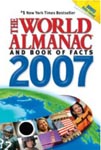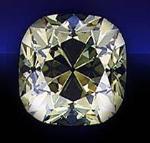VOA慢速英语 2007 0323b(在线收听)
HOST:
Welcome to AMERICAN MOSAIC, in VOA Special English.
(MUSIC)
I'm Doug Johnson. On our show this week:
We answer a question about an advertising expression‿/P>
Play some music from Sonya Kitchell‿/P>
And report about the World Almanac.
The World Almanac and Book of Facts
HOST:
Listeners to American Mosaic send us letters and e-mails asking many kinds of questions about the United States. One place we sometimes look for answers is a book called The World Almanac and Book of Facts. Barbara Klein explains.
BARBARA KLEIN:
 |
The book also provides information about the nations of the world. It tells about world history, geography, business, science and technology and languages.
It presents the most important and most unusual news stories of the past year. And it gives interesting facts, such as the nation with the most refugees (Pakistan). The nation with the most vacation days each year (Italy). And the most popular dog in the United States (Labrador Retriever).
The New York World newspaper published the first World Almanac in eighteen sixty-eight. That is why it is called The World Almanac.
The World Almanac Web site says the publication has played a part in American history. For example, in nineteen twenty-three, Calvin Coolidge was sworn in as president after the sudden death of President Warren Harding. Mister Coolidge's father, a judge, read the oath of office from a copy of The World Almanac.
The Web site also says that several recent American presidents have used the book. It says there are photographs of presidents John Kennedy and Bill Clinton that show a copy of The World Almanac on or near their desks.
The Web site also claims that The World Almanac is the best-selling American reference book of all time. It says that more than eighty million copies have been sold.
The World Almanac now also publishes a computer version as well as a separate Almanac for children. The Kids Almanac provides information children might need for school reports. It also has games, puzzles and other activities children enjoy.
Speaking of Diamonds
HOST:
Our VOA listener question this week comes from Zimbabwe. Shadreck Chikwavaire asks about the meaning of the saying “diamonds are forever.‿Many people around the world know that expression. It is the name of a popular book and movie about the fictional spy, James Bond. The theme song to the movie also became popular. Shirley Bassey sang it.
 |
Diamonds are minerals that first formed billions of years ago deep under the ground. They result when pressure and heat act on the substance carbon.
A diamond is the hardest substance found in nature. But the mineral can be cut into different shapes and used to make costly jewelry such as diamond rings. In the United States, it is traditional for a man to give the woman he plans to marry a diamond engagement ring. People also wear jewelry made of diamonds on their ears, necks and wrists.
People are willing to pay high prices for diamond jewelry. One company controls most of the diamond market -- the De Beers Consolidated Mines Company of South Africa. Reports say the company used to keep diamonds mined in many countries and released a limited number for sale each year. Officials say the company does not do business that way anymore.
The De Beers Company first created the saying "A Diamond Is Forever." In the late nineteen forties, De Beers hired an advertising agency to help increase its sale of diamonds. The agency N.W. Ayer developed an extremely successful campaign linking diamonds and romantic love.
The campaign invented the slogan “A Diamond Is Forever,‿meaning that a diamond is a never-ending sign of love. It also meant that a diamond would always keep its value. The company continues to use the slogan in its advertising more than fifty years later. And reports say it has been used to advertise diamonds in at least twenty-nine languages.
The advertising business also recognized the huge success of the saying. In two thousand, Advertising Age magazine named "A Diamond Is Forever" the best advertising slogan of the twentieth century.
Sonya Kitchell
HOST:
Sonya Kitchell writes and sings songs that are influenced by jazz and blues. She has a rich and low voice that can skillfully express many emotions and styles. The surprising part is that she is only seventeen years old. Faith Lapidus tells us more about this young artist who is making timeless music.
(MUSIC)
FAITH LAPIDUS:
 |
| Sonya Kitchell |
When Sonya was a child, her parents surrounded her with their artistic and musical interests. She started studying jazz singing at the age of ten. Soon, she started writing and performing her music live with a group.
Sonya says she tries to take in as much of the world around her as she can. Songwriting has become a way to process her experiences.
Sonya Kitchell’s first album, “Words Came Back to Me,‿came out last year. Here is, “Train,‿from that album. It is a song about wanting life to go by both faster and more slowly.
(MUSIC)
Sonya Kitchell is quickly becoming very popular. She has traveled and performed with well-known singers. Sometimes Sonya tries to write when she is on the road. But she says writing comes easiest when she is at her home in the northeastern state of Massachusetts. There, she takes walks in nature to clear her mind and think.
Sonya Kitchell says she has many goals for herself and her music. She wants to help make intelligent music more popular. She says popular music should go back to its roots and be enjoyed not only for its sound, but also for its message. We leave you with the gentle sounds of “I’d Love You.‿/P>
(MUSIC)
HOST:
I'm Doug Johnson. I hope you enjoyed our program today.
It was written by Dana Demange and Nancy Steinbach. Caty Weaver was our producer. To read the text of this program and download audio, go to our Web site, voaspecialenglish.com.
Send your questions about American life to [email protected]. Please include your full name and mailing address. Or write to American Mosaic, VOA Special English, Washington, D.C., 20237, U.S.A.
Join us again next week for AMERICAN MOSAIC, VOA’s radio magazine in Special English.